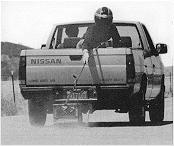Material Test Descriptions |
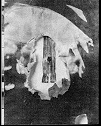 Leather Leather
Competition Weight
3 oz./sq. ft.
Initial contact instantly wiped the leather's shiny surface away, leaving a "flower petal" imprint. With a constant shushing sound, the sample settled into a continuous steady slide, exhibiting no abrupt, jerky movements typical of the extreme adhesion and snagging of destructive abrasion. Still, a chalk streak soon appeared. Inspection revealed three degrees of abrasion damage: first the partial rubbing away of the shiny surface finish; then the light brown tan of the leather; and finally the white, furry abraded natural hide beneath. In measuring and retracing the leather's route along the road, we found tiny dyed fibers in the asphalt crevices between the rock aggregates.
Distance: 86ft., 0 in.
|
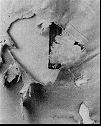 Leather Leather
Lightweight Nude Finish
2.25 oz./sq. ft.
Our sample of nude leather ruptured almost instantly. Pieces flapped the bag's bottom in long, loose ribbons , and there were other indications of severe ripping and tearing action: left behind on the roadway, snagged to the point of one particularly tall aggregate, was a 1.5-inch gouge ripped right out of the leather, only four feet after our sample hit the road
Distance: 4ft., 3 in.
|
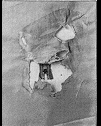 Leather Leather
Fashion Weight
1.75 oz./sq. ft.
On contact, the acrylic-finished, lime green leather eased into a clean, smooth-sounding slide-a promising sign reminiscent of the finished competition weight-leather. But shortly after touchdown, a cloud of bright green specks---like flakes of cracked paint---appeared in the samples wake, followed instantly by a thick chalk streak. The road had ground its way through the fashion sample.
Distance: 4ft., 4in.
|
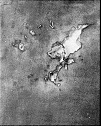 Cordura Nylon Cordura Nylon
Type 440
0.89 oz./sq. ft.
Much like the finished-leather samples, the Cordura made smooth contact with the road surface. Except for a rusty-red streak of torn fibers lest on the road, the Cordura didn't suffer a dramatic loss of material. Instead the nylon sample abraded gradually and evenly, somewhat resembling the competition -weight leather in its sound and behavior on the road-no dramatic gripping, no sounds of ripping or tearing.
Despite the very encouraging start, in a little over 18 feet the chalk streak leaked onto the drag path. The nylon sample's light weight and thinness caused it to behave something like the fashion-eight leather, though the consequences were less dramatic.
Distance: 3ft., 210 in
|
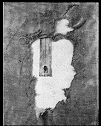 Senior Ballistic Nylon Senior Ballistic Nylon
1.5 oz./sq. ft.
The contrast in sound on the road between the finished leathers and this sample of nylon was striking: while the leather "shushed" evenly along the road, this bag made contact with a loud slap, went momentarily silent, then caught a grip of great adhesion. Suddenly, the material tore free, causing the test rack to hop into the air before crashing back down in a spray of chalk. This hop left its mark: dark ripples, much like shock waves radiated from the bag's torn contact area to the edges of the sample.
Distance: 3ft., 10in.
|
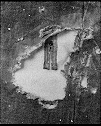 Denim Denim
(New)
1.6 oz./sq. ft.
The jeans abraded in distinct, rapid stages: first the cotton's finish instantly wiped away, leaving a faint blue tint on the road's gray surface. Seen bouncing in the sample's trail were hundreds of tiny denim balls. By this time, a loud tearing sound indicated the road had already taken hold of the denim's cotton yarns. Before this white debris blew from the crate's bottom, the chalk signaled the test's end.
Distance: 3ft.,10in,
|
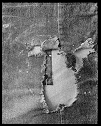 Denim Denim
(2 yrs. old)
1.6 oz./sq. ft.
The results for this sample paralleled those of the new jeans, thought the first of three stages of deterioration was less apparent because little blue bye remained in the faded two-year-old jeans. Whether acting on new or old jeans, navy blue or faded, the road easily ground away these samples and left them in ribbons.
Distance: 4ft., 5in.
|
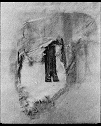 Kevlar 29 Kevlar 29
Aramid-Style 713
0.19 oz./sq. ft.
Initial contact caused a dull-yellow imprint, yet beyond this stain, the Kevlar left little visible material on the road. A heavy, gritty sound accompanied the drag, indicating the scuffing was more a grind than a slide. Despite the sound, the Kevlar sample left little debris behind- and no chalk until the bag traveled 22 feet down the road. A post-check showed extensive unraveling where the aggregates has penetrated and pulled the yarns of Kevlar out of their wave, Still, these aramid strands, heavily scuffed and abraded, had strongly resisted the road grinder.
Distance:22ft.,1 in.
|
